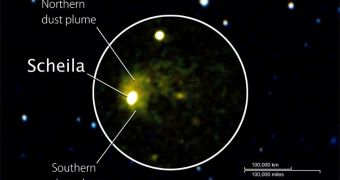In late 2010, astronomers observed an asteroid that apparently changed its brightness over time. In a series of investigations that were concluded recently, experts manage to establish and prove that this phenomenon was caused by collisions between two or more space rocks.
This is the only possible way of explaining this change in brightness, scientists say. The work was conducted on the asteroid dubbed 596 Scheila, which was observed throughout December 2010.
At the same time that the space rock started showing increases in brightness, astronomers also discovered what would later turn out to be temporary dust plumes around it. These plumes may have also been produced by the collisions, the two new studies propose.
Using datasets collected by the NASA Spitzer and Hubble space telescopes, scientists determined that 596 Scheila most likely collided with another, smaller space rock. This event may have led to the creation of dust plumes, as material from both objects spread out around them.
The collision took place in the Inner Asteroid Belt (IAB), a region of the solar system between the orbits of Mars and Jupiter that houses millions of such space rocks. Astronomers believe that these asteroids were produced alongside all the planets, some 4.6 billion years ago.
At 70 miles (113 kilometers) in diameter, 596 Scheila can be considered rather large. Studies have shown that it completes an orbit around the Sun in around 5 years. Data from the two NASA telescopes indicate that the last pass did not go over so well.
“Collisions between asteroids create rock fragments, from fine dust to huge boulders, that impact planets and their moons,” explains University of Maryland investigator Dennis Bodewits. He is the lead author of the study conducted using infrared Spitzer data.
“Yet this is the first time we've been able to catch one just weeks after the smashup, long before the evidence fades away,” he goes on to say, quoted by Space. The expert adds that 596 Scheila began releasing its dust plumes between November 11 and December 3, according to archive images.
Data collected using the Hubble telescope showed that the asteroid was not simply passing through a cometary outgassing phase. Some asteroids can become active comets for short periods of time, and release water vapors, but this is not what happened to 596 Scheila.
“The Hubble data are most simply explained by the impact, at 11,000 [miles per hour] (17,703 kph), of a previously unknown asteroid about 100 feet (30 meters) in diameter,” says University of California in Los Angeles (UCLA) expert David Jewitt, the leader of the Hubble study.
The two investigations will be published in the upcoming, May 20 issue of The Astrophysical Journal Letters.

 14 DAY TRIAL //
14 DAY TRIAL //